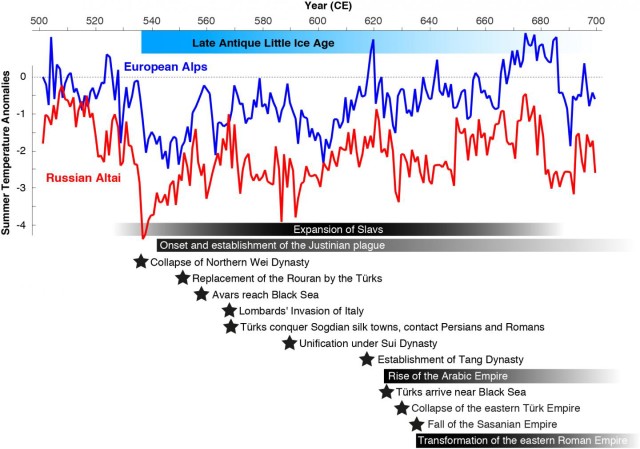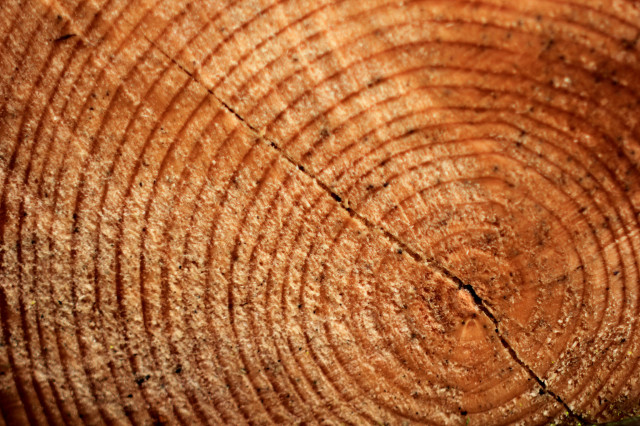
Summer temperatures were reconstructed from tree rings in the Russian Altai (red) and the European Alps (blue). Horizontal bars, shadings and stars refer to major plague outbreaks, rising and falling empires, large-scale human migrations, and political turmoil. (Past Global Changes International Project Office)
Much has been written about the wide reaching impact of the “Little Ice Age,” a period of global cooling that lasted approximately from the mid-13th to the mid-19th centuries.
Now, an international team of researchers say they have come across another extraordinary, extended period of cooling that took place in the northern hemisphere between 536 to around 660 AD, and have connected it to some significant and transformative changes in world history.
This multidisciplinary research team, made up of climatologists, naturalists, historians and linguists, is part of the Past Global Changes Project (PAGES). The team examined tree rings from the Russian Altai and European Alps to gauge summer temperatures over the past 2,000 years. Scientists say that tree ring width can be used to reliably estimate summer temperatures.
Calling it the “Late Antique Little Ice Age,” the researchers say this roughly 150-year drop in temperature began soon after three large and successive volcanic eruptions in 536, 540 and 547 AD.
Large amounts of volcanic ash and particulates that get blasted into the atmosphere form a dusty veil that shields the Earth from incoming sunlight.
Periods of cooling and other climatic changes have long been linked with volcanic eruptions.
Because of reduced sunlight and cooling temperatures it is thought that food supplies were most likely affected by these volcanic eruptions, since there were reports of major famine at that time.
The researchers note that the world’s first recorded pandemic, known as the Justinian Plague, named after the 6th century Byzantine emperor Justinian I, which swept through the Mediterranean area and killed millions of people, began in 541, only five years after the start of the “Late Antique Little Ice Age.”

Researchers analyzed tree rings to reconstruct summer temperatures for the last 2,000 years. (Christian Schnettelker via Flickr/Creative Commons)
Outlining their findings in a study published by the journal Nature Geoscience, the researchers propose that the drop in temperature, subsequent famine, plague pandemic and other associated events may have played a role in one of the most tempestuous periods in European and Central Asian history.
“This was the most dramatic cooling in the Northern Hemisphere in the past 2000 years,” said the study’s lead author, Ulf Büntgen of the Swiss Federal Research Institute in a press-release.
However, farther south, in the Arabian Peninsula, conditions were quite the opposite.
The normally hot and arid region received more rain than usual during this time, which in turn produced much more plant life.
The researchers say that the increase in vegetation helped produce and expand herds of camels which were used by armies to carry out successful military operations that spawned and grew the Arab Empire.
Büntgen points out that the research conducted by the PAGES team demonstrates how sudden changes in climate can have an impact on the world’s political systems.






















Comments are closed.